Tyres occupy a special place in the mountain biker’s heart. Mountain bikers are very, very interested in tyres. Finding yourself with inappropriate tyres can really spoil a ride if you let it. Here is some sagely advice.
Tyres are the only things on your bikes that are in contact with the ground. They affect acceleration, grip, momentum, cornering and braking. Tyres are important.
Mountain bikers love rubber.
 How tyres and tubes work
How tyres and tubes work
Tyres are essentially cloth covered by rubber.
The cloth is called the carcass.
The rubber is called the tread. All mountain bike tyres are ‘clinchers’.
Clinchers’ cloth casings wrap around two beads (wire or fibre). These beads interlock with flanges in the rim.
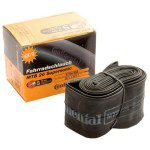 Inner tubes or tubeless systems?
Inner tubes or tubeless systems?
All bike tyres can work with inner tubes. Even tubeless tyres work with inner tubes. Inner tubes are usually made from butyl but you can get some delicate lightweight latex ones.
A tubeless tyre system does away with the inner tube and replaces it with liquid sealant that keeps the air in. To add or remove air you use a screw-in valve that’s located in the usual valve hole in the rim.
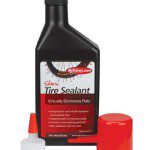
The idea of tubeless systems is to remove the chance of punctures because there is no inner tube to pinch puncture between the tyre and the rim.
To run a tubeless system you need a tubeless compatible tyre and a tubeless compatible rim. If you don’t have tubeless rims don’t worry, there are a number of tubeless conversion kits available.
As well as a tub of sealant and a screw-in rim valve, a tubeless conversion kit contains specially designed rim strips to cover up the spoke holes in an airtight manner.
How tyres and tubes differ
Carcass
Usually nylon. The thread count (Threads Per Inch or TPI) in the cloth affects the weight and performance of the tyre. The more threads the lighter and more supple the tyre. This is not necessarily better for certain types of mountain biking. Riding that involves technical rough terrain at speed is better done with lower TPI tyres with firmer, stronger carcasses.
Tread
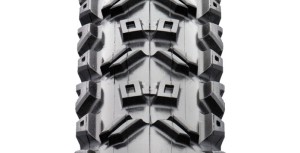
Knobbles and rubber compounds. Tread pattern is the shape and size of the knobbles on the tyre. The tread often has different shaped knobbles on different parts of the tyre for doing different duties such as traction, cornering, mud-shedding, braking forces and rolling resistance.
Rolling resistance is another word for drag really. Spiky knobble tyres have more rolling resistance than slick tyres, for example.
Tyres can be made from different rubber compounds. Some tyres are made from firm rubber which lasts longer but offers less grip. Other tyres are made from softer rubber which offer more grip but don’t last as long.
There are also multi-compound tyres which use different rubber compounds in different parts of the tyre ie. firm rubber centre knobbles for durability and soft rubber side knobbles for cornering grip.
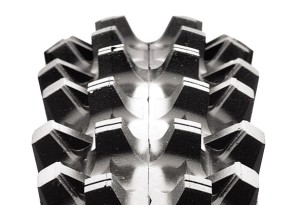
The cross-section profile shape of a tyre also varies. Some tyres are round in profile, others are more square with very pronounced ‘shoulders’.
A tyre’s tread pattern and compound are specifically chosen to handle in specific ways in specific conditions. And some tyres are better suited to use on the rear wheel, others for use up front.
Beads
Wire beads make for a cheaper tyre but they’re also heavier and can’t be. Fibre/Kevlar beads are lighter and can be folded which makes for easier storage when they’re off the bike.
Sizes
Mountain bike tyres come in three diameters: 26, 27.5 and 29 inch. You need to choose the correct diameter for your wheels. They aren’t interchangeable.
Tyres come in various widths. The most common range is between 2.1 and 2.5 inch widths. Generally narrower tyres are for smoother trails and wider tyres are for rougher stuff.
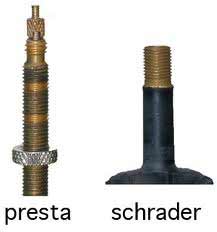 Inner tubes
Inner tubes
Most inner tubes are made from butyl. Some delicate lightweight ones are latex.
Like tyres, tubes come in different diameters (26, 27.5, 29 inches) and different volumes (1.5 to 2.5 inches in various increments). It’s best to get the inner tube volume that matches your tyre width.
Inner tube valves come in two sorts: schraeder and presta. Most keen cyclists prefer presta as they’re more precise in operation. Schraeder valves are more common on entry level bikes. Some rims won’t accept schraeder valves. All rims accept presta valves.
Which tyres should you buy?
Leisure riders should look for tyres that are durable but not so firm a rubber as to be lethally slippy in damp conditions. A 2.25 inch tyre in a 50a or 60a compound with mid-sized knobbles will be a good all-round choice. Use the same tyre for both front and rear. There’s no need to bother with tubeless.
Regular riders should be looking at two different tyres: one tyre for front use and one for the rear. The front tyre should be made from soft compound ’42a’ or ‘50a’ rubber and have a relatively square profile. The rear tyre can be made from firmer rubber (50a or 60a), have a round-ish profile and a stiff low TPI carcass. If you’ve never tried tubeless, you should really think about it. Once it’s set up (which can be a faff admittedly) there’s no more puncture woes.
Racers will buy a lot of different tyres for all sorts of different riding conditions. From 2.0 mud spikes through to 2.4 semi-slicks they’ll want them all in their armoury. They will always buy the best because they know that races can be won or lost on tyre performance. Often racers find a brand that they like and stick to tyres from that brand. Tubeless is a must.

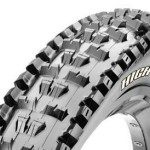 How tyres and tubes work
How tyres and tubes work
Pingback: How to Go Tubeless | Merlin Cycles Blog
I’m about to change my front and back mtn bike tires for the first time. I think this article will help out quite a bit, thanks!